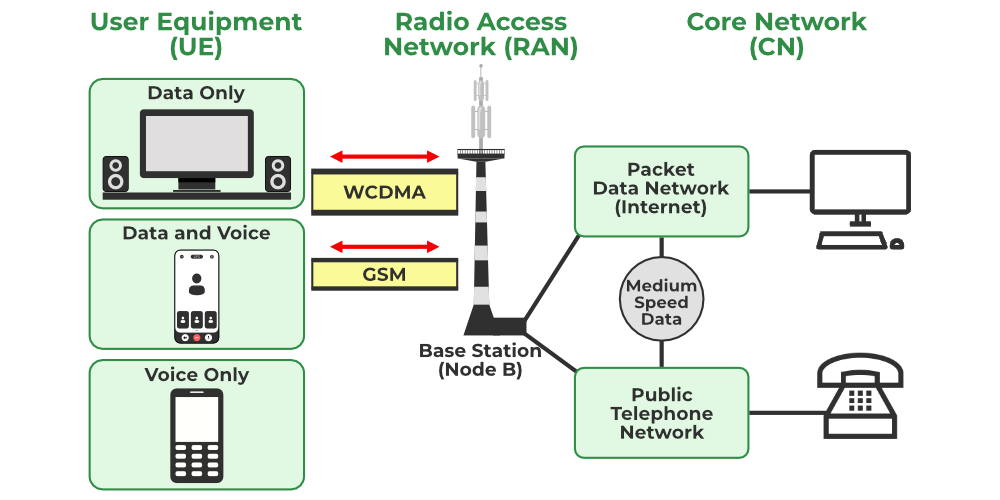What is WCDMA (Wideband Code Division Multiple Access)? A Comprehensive Guide
telcomatraining.com – In today’s world of mobile telecommunications, the demand for faster, more efficient communication networks is ever-growing. As technology continues to evolve, new methods of connecting devices emerge to meet these demands. One such method is WCDMA, or Wideband Code Division Multiple Access, a key technology in modern mobile networks. In this comprehensive guide, we’ll explore what WCDMA is, how it works, its advantages, and its role in mobile communications.
What is WCDMA?
WCDMA stands for Wideband Code Division Multiple Access. It is a third-generation (3G) mobile communication technology that uses a wideband spectrum to provide high-speed data transmission, enabling better voice quality and internet access for mobile users. WCDMA is a type of Code Division Multiple Access (CDMA), a radio communication technology that allows multiple users to share the same frequency spectrum simultaneously.
WCDMA operates in a wider frequency band compared to traditional CDMA, which means it can handle more data and offer higher-speed connections. It is commonly used by mobile carriers worldwide and is a crucial part of 3G networks.
How Does WCDMA Work?
WCDMA utilizes a technique known as “code division” to distinguish between different users on the same frequency band. Each user is assigned a unique code, which the network uses to separate their data from others. The system spreads the data across a wide frequency range, minimizing interference and allowing multiple users to access the network at the same time.
The technology relies on a concept called “spreading codes.” These codes are unique to each user and help the network differentiate between users even if they are using the same frequency. This allows for higher capacity and more efficient use of the available bandwidth.
Key Features of WCDMA
- High Data Rates: One of the key benefits of WCDMA is its ability to provide high-speed data transfer. With data rates reaching up to 384 kbps for mobile devices, it supports applications such as video calling, online gaming, and mobile internet browsing.
- Improved Voice Quality: Unlike previous 2G technologies, WCDMA offers significantly better voice quality. The technology can transmit voice data at higher bit rates, making calls clearer and more reliable.
- Global Standard: WCDMA is used as the foundation for 3G networks across the world, enabling global roaming and seamless connectivity across different countries and regions.
- Efficient Spectrum Utilization: WCDMA uses a wide frequency spectrum, allowing it to carry more data and serve more users simultaneously compared to earlier technologies like GSM (Global System for Mobile Communications).
Advantages of WCDMA
- Enhanced User Experience: WCDMA delivers a superior mobile internet experience, offering faster browsing, seamless video streaming, and quicker downloads compared to earlier 2G technologies.
- Better Capacity and Coverage: WCDMA’s ability to handle more users and traffic within the same frequency spectrum ensures that the network can support more simultaneous connections. It also provides wider coverage, especially in rural and remote areas.
- Improved Voice and Video Services: With WCDMA, users can enjoy high-quality voice calls and video calls, making it ideal for applications like Skype and FaceTime, which demand a stable, high-quality data connection.
- Future-Proofing: As mobile technology continues to evolve, WCDMA has paved the way for newer, faster networks like 4G and 5G. Many 4G LTE networks have evolved from WCDMA technology, providing a smoother transition as mobile networks upgrade.
The Role of WCDMA in Mobile Networks
WCDMA serves as a critical technology for 3G mobile networks. It enables users to enjoy faster data speeds, improved voice quality, and better overall connectivity. While newer technologies like 4G and 5G are beginning to take the spotlight, WCDMA remains an essential component of mobile communication systems.
In many regions, WCDMA continues to support a large portion of mobile traffic. It’s used by millions of people every day for tasks such as browsing the internet, sending emails, and making phone calls. Additionally, as 5G networks are being developed, WCDMA still plays a role in providing 3G fallback options for areas where newer technologies aren’t yet available.
Conclusion
WCDMA (Wideband Code Division Multiple Access) is a revolutionary mobile technology that has played a significant role in the development of 3G mobile networks. With its ability to provide higher data speeds, enhanced voice quality, and improved coverage, it has significantly changed how we use mobile phones. While newer technologies like 4G and 5G have emerged, WCDMA remains an important part of mobile communication, ensuring that users continue to enjoy high-quality services worldwide.
As the mobile landscape continues to evolve, the role of WCDMA in providing fast, efficient, and reliable connectivity remains essential. Whether you’re making a call, streaming a video, or browsing the internet, WCDMA technology ensures that the mobile network can keep up with your demands.







